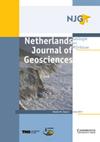荷兰格罗宁根东部米德沃尔达附近萨里安地形的冰川地质
IF 2.3
2区 地球科学
Q3 GEOSCIENCES, MULTIDISCIPLINARY
Netherlands Journal of Geosciences-Geologie En Mijnbouw
Pub Date : 2018-12-01
DOI:10.1017/njg.2018.16
引用次数: 0
摘要
由于2011年和2014年的挖渠活动,对荷兰格罗宁根Midwolda冰川脊的2个小临时暴露和1个大临时暴露进行了沉积学和构造地质学研究,深度均为4 ~ 5 m。最下面的单元由埃尔斯特时代的粘土组成,由冰湖沉积和浊积沉积(Peelo组)组成。显示了同沉积期的加载变形,以及沉积后的萨利安期冰川构造变形,包括褶皱和断裂构造。上覆的萨里亚till序列由两个主要单元组成。下部单元具有明显的冰下变形带特征(如侧向非均质性),具有局部成因,与下伏的埃尔斯特系粘土非常相似。冰川构造和形态观测表明主要的冰流方向为NE-SW。第二层为砂质结构,结晶砾石含量高,冰川构造指示为北西-东南冰流方向。由于最后一次冰的运动,土层的变形造成了土层的重复和混合。北西-东南方向的冰运动得到了形态和不规则砾石计数数据的支持。与地质剖面的对比强有力地表明,区域地下控制着冰盖的行为。本文章由计算机程序翻译,如有差异,请以英文原文为准。
Glacial geology of Saalian relief around Midwolda, eastern Groningen, the Netherlands
Abstract Due to canal-digging activities in 2011 and 2014, two small and one large temporary exposure, all ranging from 4 to 5 m in depth, were studied with respect to the sedimentology and structural geology, in the glacial ridge of Midwolda, Groningen, the Netherlands. The lowermost unit consists of clay of Elsterian age and is composed of glaciolacustrine and turbiditic deposits (Peelo Formation). These show synsedimentary deformations due to loading, as well as post-sedimentary Saalian glaciotectonic deformations, consisting of folding, and faulting structures. The overlying Saalian till sequence consists of two main units. The lower unit, with clear features of a subglacial deformation zone (e.g. lateral heterogeneity), has a local origin and strongly resembles the underlying Elsterian clay. Glacial tectonic and morphological observations indicate a primary NE–SW ice-flow direction. The second till layer has a sandy texture and high crystalline gravel content, while glacial-tectonic indicators point to a NW–SE ice-flow direction. The deformation of the till layers has caused a repetition and mixing of till layers, due to the last ice movement. The NW–SE ice movement is supported by the morphology as well as data from erratic gravel counts. Correlation with geological cross-sections strongly suggests regional subsurface control on ice-sheet behaviour.
求助全文
通过发布文献求助,成功后即可免费获取论文全文。
去求助
来源期刊
CiteScore
4.00
自引率
25.90%
发文量
14
审稿时长
>12 weeks
期刊介绍:
Netherlands Journal of Geosciences - Geologie en Mijnbouw is a fully open access journal which publishes papers on all aspects of geoscience, providing they are of international interest and quality. As the official publication of the ''Netherlands Journal of Geosciences'' Foundation the journal publishes new and significant research in geosciences with a regional focus on the Netherlands, the North Sea region and relevant adjacent areas. A wide range of topics within the geosciences are covered in the journal, including "geology, physical geography, geophyics, (geo-)archeology, paleontology, hydro(geo)logy, hydrocarbon exploration, modelling and visualisation."
The journal is a continuation of Geologie and Mijnbouw (published by the Royal Geological and Mining Society of the Netherlands, KNGMG) and Mededelingen Nederlands Instituut voor Toegepaste Geowetenschappen (published by TNO Geological Survey of the Netherlands). The journal is published in full colour.

 求助内容:
求助内容: 应助结果提醒方式:
应助结果提醒方式:


